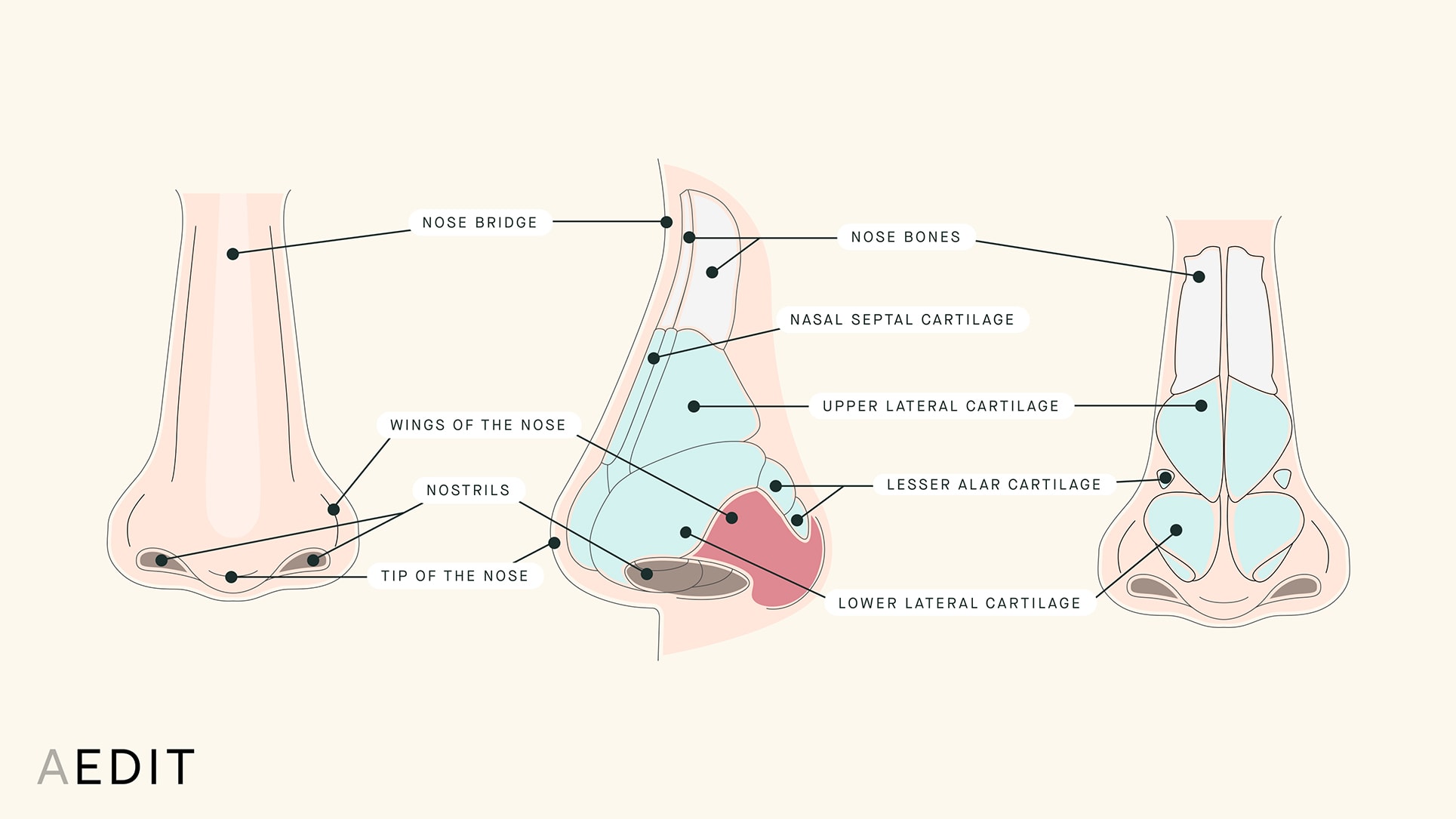What causes cosmetic breathing concerns?
With a basic understanding of nasal anatomy, it is easy to see how subtle abnormalities in the nasal structure can have a significant impact on its function. The nose is the first organ in the respiratory system and is composed of bone and cartilage. The septum vertically divides the nose in half, which, in turn, creates the two nostrils.
The Anatomy of the Nose
The nostrils open into an intricate system of hollow curving passageways known as the nasal turbinates that moisten and warm air before sending it to the lungs. As we discussed in our guides to nose shape and nose size, the lungs prefer to receive air that is sufficiently warm and moist, which is why geography plays a role in determining the shape and size of a person's nose. People with ancestors from hot, humid climates tend to have shorter, wider noses, while those from cool, dry environments have longer, narrower sniffers.
But the shape and size of the nose aren't the only factors in determining how air is delivered to the lungs. Deviations in the nasal septum (a.k.a. a "deviated septum") can cause a narrowing of either nostril that may be significant enough to impact air flow to a noticeable level. In severe cases, the structural asymmetry can even be visible to the naked eye (1).
What are the main concerns related to cosmetic breathing issues?
The American Lung Association identifies a host of medical conditions — ranging from lung disease and chronic obstructive pulmonary disease (COPD) to hypertension and asthma — not directly related to the structure of the internal or external structure of the nose that can cause trouble breathing (2). But, as it relates to the nose itself, the following concerns could lead to breathing issues:
Deviated Septum: The common condition occurs when the cartilaginous “wall” separating the two nostrils “deviates” to one side or the other, constricting the nostrils and can vary in severity (1).
Nasal Structure: The size and shape of the nose and nostrils contribute to the overall structure of the nose. While such factors are genetically predetermined, they can be altered by injury, age, or medical conditions (like nasal polyps,
nose bumps, and
nose angle) that may impact breathing (3).
Nostril Size: The size of the nostrils is determined by the shape of the nose and the size of the septum. Nostrils considered to be too large may become an aesthetic concern, while nostrils that are too small can cause breathing difficulty secondary to reduced air flow (3).
Who may wish to seek treatment for cosmetic breathing issues?
Once more serious illness has been ruled out, if breathing issues persist secondary to a structural cause a consultation with a plastic surgeon can be very beneficial. Studies have shown that 75 to 80 percent of humans have some deviation of the nasal septum — one of the most common causes of breathing difficulties due to reduced airflow through the respiratory system (4).
Given the ubiquity of this type of complaint, researchers have created a rating system known as the Nasal Obstructive Symptom Evaluation Scale (NOSE) to judge a patient's degree of nasal obstruction and practitioners to assess if plastic and reconstructive surgery is an appropriate solution (5). In most cases, procedures to correct respiratory issues can also be used to make alterations to nose shape and size.
How can someone get help for cosmetic breathing issues?
Whether a patient's concern is related to the size or shape of the nose and nostrils (read our guide to nose size concerns and nose shape concerns) or a deviated septum, there are reconstructive and cosmetic surgery that can improve breathing, while also amending the aesthetic appearance of the nose.
Check out our full guide to Cosmetic Breathing Solutions, or read on for an overview of the treatment options:
For Deviated Septum
A septoplasty procedure, during which a surgeon clears obstructed airways by straightening the septum and evaluating the blocked nasal structure to remove any impediments, is used to correct a deviated septum. When combined with a rhinoplasty (a.k.a. nose job), which addresses the external structure of the nose, the dual surgery is known as a septorhinoplasty.
For Nose Structure
A rhinoplasty comes in a variety of surgical and non-surgical forms. As it relates to correcting the shape or size of the nose for improved breathing, a plastic surgeon can use either an open rhinoplasty or closed rhinoplasty technique to straighten the nose, adjust the size, change the nasal angle, or enhance the nasal bridge for improved air flow.
For Nostril Shape and Size
Combined with a rhinoplasty or performed alone, an alarplasty surgery can correct the symmetry and size of the nostrils. An incision is made between the nose and cheek whereby excess skin is removed to allow the nostrils to be reshaped and/or sized.



